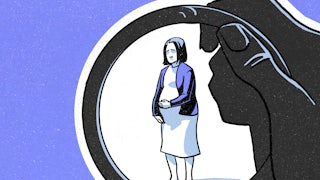With its June decision in Dobbs v. Jackson Women’s Health Organization denying the constitutional right to abortion, the Supreme Court introduced a whole host of new and reasonable fears about abortion access and technology. The sheer scale of the data that computers, phones, and other devices collect from users on behalf of tech platforms expands the reach of the law into what was believed to be legally protected territory: if, when, and how to choose to have a child.
But quietly sitting on the books, where it’s been for nearly three decades, is a law that explicitly makes it a crime to discuss abortion online. The Telecommunications Act of 1996 was the first major attempt by Congress to define what would be lawful on the internet. The act includes a provision that criminalizes discussing abortion, with potential punishment of up to five years in jail, $250,000 in fines, or both. No one has ever been charged with violating this provision of the law. When President Bill Clinton signed the act, he said he objected to its ban on abortion-related speech and that the Justice Department advised him that such a ban was unconstitutional; the next day, Attorney General Janet Reno informed Congress that her department would not defend the constitutionality of the provision, nor would it be enforced. To date, the DOJ has not changed its policy on enforcing the ban.
But since the Supreme Court reversed Roe v. Wade, much of the previously established legal terrain on abortion now appears uncertain. U.S. Attorney General Merrick Garland likely has no intention of enforcing a ban on abortion-related speech online, but it is not difficult to imagine that a future anti-abortion presidential administration would seize upon this largely forgotten part of internet law.
Over the last several weeks, abortion rights and digital security activists have had to advise increasing numbers of people seeking abortion information on and over the internet. They have helped them weigh their risks—of their search histories, geolocation data, or group chats becoming evidence to be used against them in court—against the reality of which law enforcement actions are more or less likely. But to date, there has been little public discussion or debate about the one provision in the law directly aimed at outlawing abortion-related speech online.
The story of the prohibition begins with the Christian right. Groups such as the Family Research Council, the American Family Association, and Morality in Media lobbied Congress in the early 1990s to pass a law to ban “computer pornography” or anything else they deemed “indecent.” As this campaign approached victory in 1995, only about 20 percent of the few million internet users in the United States said they went online “every day,” and only 3 percent of all Americans had gone on the two-year-old World Wide Web. As is its norm, the right couched this ban on speech as its duty to protect children. The result was the Communications Decency Act, a new section of the Telecommunications Act. The majority of this new section contains provisions restricting speech, alongside one measure—Section 230—aimed at enabling free speech online.
One of the Christian right’s allies in Congress, the Illinois Republican Representative Henry Hyde, who is perhaps best known for his 1978 amendment barring the use of federal funds for abortion, would also put his mark on the CDA. The provision Hyde inserted would effectively criminalize abortion-related speech online. This “noxious abortion portion” of the CDA, Michigan Democrat Representative John Conyers said during debate, was introduced without notice and late in the process. At the same time, Hyde claimed that “nothing” in his late addition to the bill should be “interpreted to inhibit free speech” about abortion. Immediately, Hyde tried to downplay its potential ramifications, with aides pushing the idea that it didn’t amount to much, while also dismissing its critics’ concerns as the hysterical product of women’s rights groups. Morality in Media’s general counsel, Paul McGeady, said that the Hyde provision “was added … without adequate counsel” but also claimed that it was “a dead issue,” given the Department of Justice policy of nonenforcement. Somehow, in the views of Hyde and his supporters, the provision was essential to include and also did nothing.
Reproductive rights advocates knew better. Hyde had used the CDA to update the Comstock Act of 1873, “An Act for the Suppression of Trade In, and Circulation of, Obscene Literature and Articles of Immoral Use,” named for the anti-feminist, anti-pornography and prostitution, and anti-abortion and contraception crusader Anthony Comstock. It outlawed the sale and distribution of “obscene, lewd, lascivious, or filthy” materials, including “any drug, medicine, article, or thing designed, adapted, or intended for producing abortion, or for any indecent or immoral use,” along with any materials “giving information, directly or indirectly, where, how, or of whom, or by what means any of such mentioned articles, matters, or things may be obtained or made.” Hyde’s provision in the CDA added to the act’s original catalog of distribution methods, such as the postal mail, the words “interactive computer service.”
The Hyde/Comstock provision remains in the law despite two legal challenges. The first, Sanger v. Reno, was brought by reproductive rights groups—Sanger being a descendant of Planned Parenthood founder Margaret Sanger—who charged that the provision was a violation of their First Amendment rights. The second, ACLU v. Reno, challenged the CDA as a whole and sought a restraining order that would have blocked the act from going into effect. But with both then–Attorney General Reno and President Clinton on the record saying that no one would be prosecuted under the Hyde/Comstock provision, the district court judges in both cases ruled that since there was no imminent threat of enforcement, there was no basis to proceed with either challenge. As a result, even though the Department of Justice would not defend the provision and did not believe it was constitutional, it survived these challenges.
Still, to some, it appeared the issue was closed: The ban on abortion-related online speech was a dead letter. No one was willing to enforce it, starting under Clinton and carrying through subsequent administrations—so it likely felt moot since abortion was a constitutionally protected right. But without any definitive judgment on the provision, there was no way, as one reproductive rights attorney said at the time, “to prevent a future administration or radical right-wing members of Congress from wielding it against women’s health care providers and advocates.” That lack of a ruling is arguably even more of a threat now, post-Dobbs.
The ACLU could bring that challenge, said Brian Hauss, senior staff attorney at its Speech, Privacy, and Technology Project. “Even when it was first enacted, it was widely recognized … that the law blatantly violated the First Amendment,” Hauss told me. The loss of Roe doesn’t necessarily change that. “The Supreme Court has never recognized that the government has a legitimate, let alone important or compelling, interest in suppressing speech about abortion—that remains true, with or without Roe.” However, without some threat of imminent enforcement, like a new administration’s Department of Justice announcing it intends to charge people under the provision, a pre-enforcement challenge would be difficult, Hauss said. “The best course of action would be for Congress to repeal these provisions.”
Congress did previously try to kill Hyde’s provision, before the Telecommunications Act was even signed into law. Two Democrats, Senator Frank Lautenberg of New Jersey and Representative Patricia Schroeder of Colorado, proposed amending the Comstock Act of 1873, removing abortion from its prohibitions. Lautenberg’s remarks at the time invoke a much earlier internet: “Women can also obtain information about clinics in their area over the Internet. Within the last month and a half alone, over 1,500 people have accessed such an Internet site. Under this new law, these 1,500 persons potentially could have been arrested, fined up to $250,000, or sent to prison for five years.” Yes, Clinton’s Department of Justice said it would not prosecute those people. “But what if Pat Buchanan wins the Presidency? Or Bob Dole? Zealous prosecutors in their administrations might well use the new law to harass people who are pro-choice, and to chill speech about abortion over the Internet.” To allow the Comstock Act to remain on the books leaves us in more peril now as anti-abortion legislators and law enforcement more broadly are newly energized to find further ways to police access in all forms—by restricting medications that have the chance of ending pregnancy or other attempts to limit access to information.
In looking to the law for protection after Roe, digital rights advocates have pointed to the Communications Decency Act as an essential front in the fight to defend abortion-related speech on the internet. Democrats such as Senator Ron Wyden have vowed to safeguard these protections, outlined in CDA Section 230, which he co-authored in an effort to enable free speech online. Section 230 protects users’ speech in the sense that it protects people and platforms who host or republish content from being held legally responsible for that content (with some notable exceptions, most recently the content excluded by the anti–sex work law SESTA/FOSTA).
Yet even in considerations of how the CDA impacts abortion-related speech, the Hyde/Comstock provision remains largely ignored. That may well be because advocates have been assured the provision is unconstitutional. But we know from the fate of Roe that the U.S. is in very unsettled territory when it comes to what constitutional rights the current courts see fit to uphold.


